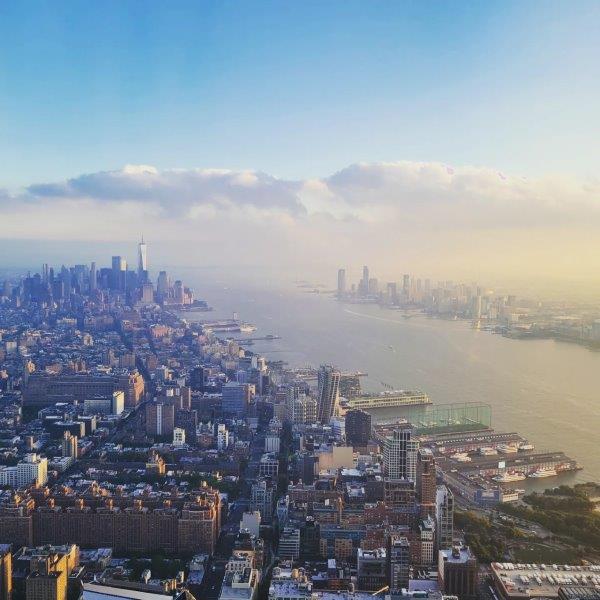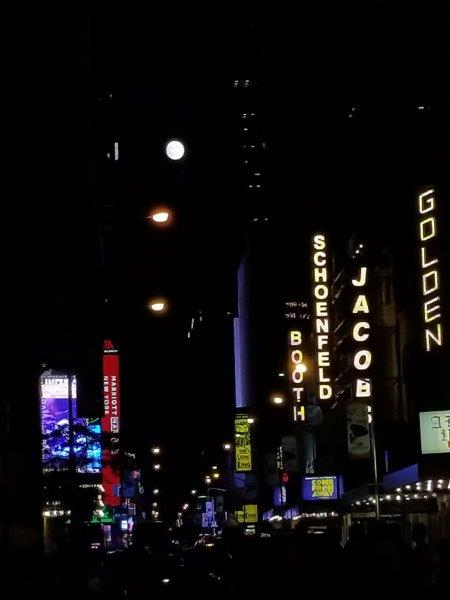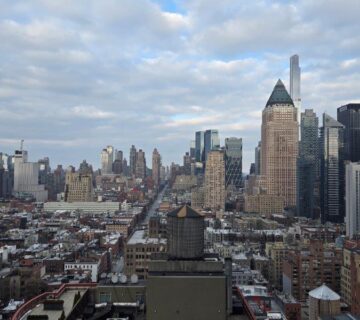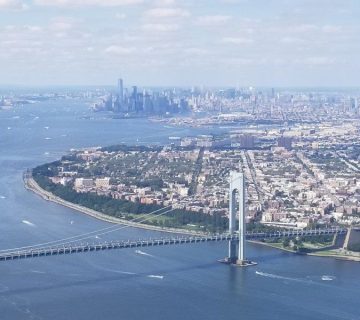New York City, often heralded as the epitome of the American dream and a global cultural mecca, finds itself at the center of a surprisingly heated debate: Is NYC overrated? As a New Yorker who has made NYC home since 1999, I find this question both surprising and unexpected, and one that I am happy to answer with a resounding no as I love everything that New York City has to offer. It goes beyond the usual iconic landmarks such as the Statue of Liberty and Central Park, and offers a rich tapestry of arts, entertainment, and business that truly makes it the crossroads of the world in more ways than one. With its perpetual buzz and the promise of endless opportunity, New York carries a reputation that sometimes seems larger than life itself.
While there is a common belief that New York City is too expensive and unafforable for most, I believe they are confusing Manhattan with New York City, which happens often. New York City is comprised of five boroughs, Manhattan, Queens, Brooklyn, Staten Island and the Bronx. The cost of living is decidedly more affordable outside of Manhattan, which is where most of NYC’s 8.3 million population chooses to live.
What I do find understandable is that while some view the city’s energy as invigorating, others suggest it can be overwhelming, highlighting a divide in perceptions that strikes at the heart of New York’s global esteem. New Yorkers like to work hard and party hard, often at the expense of a work life balance, which is a choice that New Yorkers are happy to make given all that we gain from living in NYC.
Amidst a chorus of diverse opinions, the city’s true character remains a complex subject. Whether considering New York to be overrated or not depends heavily on individual expectations and experiences, and it is not a city that is well suited for everyone. It is, however, hard to ignore York City’s influence on commerce, fashion, art, and cuisine, which makes it a significant point of reference for cities around the world, cementing its status as a central hub for innovation and cultural exchange.

Table of Contents
Debunking the Myth of NYC
New York City often finds itself at the center of discussions on whether it is deserving of its iconic status or if it is, in fact, overrated. This section will explore what being ‘overrated’ means and will measure New York City against other major cities to understand the merit of this claim.
Is New York overrated?
Very literally, an overrated entity is something perceived to receive more praise than it merits. Factors often quoted in relation to New York City being overrated include its high cost of living, perceived rudeness of its inhabitants, and the challenges associated with urban density. However, such criticisms need to be weighed against the city’s diverse cultural offerings, economic opportunities, and historical significance to get a balanced view.
- High Living Costs: New York City is considered to be expensive as a blanket statement, but that is not true. Some parts of NYC are more expensive than others, but the cost of living varies significantly between its various boroughs and neighborhoods.
- Urban Density: The city’s density is often associated with noise and crowds, yet this also fosters a vibrant, energetic urban environment.
- Cultural Offerings: New York’s rich tapestry of art, cuisine, fashion, and entertainment is unparalleled.
Relative Comparison with Other Cities
When comparing New York City to other cities, it’s essential to consider a variety of factors.
- Cultural Impact: New York City boasts an impressive array of museums, theaters, and galleries that are considered best in class, and are often trendsetters on a global stage.
- Economic Opportunities: As a global financial hub, opportunities in New York City are vast and varied.
- Quality of Life: While expensive, the city offers immense conveniences, amenities, and services that are unmatched. Affordability is a significant concern for many residents, most of whom live in boroughs other than Manhattan, and the high cost of living intersects with economic factors which shape the city’s demographic and social dynamics.
By most standards, when the full scope of what New York City has to offer is taken into account, the city’s reputation seems to be built on solid grounds. It’s key to remember that the value and appeal of urban experiences are subjective and differ greatly from person to person.
Cultural Perspectives
New York City boasts a complex cultural landscape with a vibrant art and culture scene, diverse food experiences, and an entertainment industry epitomized by Broadway.
Art and Culture
New York City’s art scene is as diverse as its population, featuring world-renowned museums like the Metropolitan Museum of Art and cutting-edge galleries in neighborhoods like Chelsea and Bushwick. The leading museums such as the Met offer pay what to wish entry to New Yorkers, making art accessible to locals that can pay as little as $1 to go in. Most museums have free days where anyone, including tourists, can experience them for free. The city also abounds in free art and culture events, espcially in the summer, where it is possible to soak in all that New York is famous such as the New York Philharmonic performing for free in all the boroughs without needing to pay a penny.
In addition, New York City has public art exhibits for free in public spaces at all times.

Food and Dining
When it comes to food and dining, New York City is a smorgasbord of options across all budgets, ranging from a $1 slice of pizza to a three star Michelin dining experience. NYC’s food and dining options range from the fashionable food trends of bistro eateries to the timeless appeal of a slice of pizza in a no-frills setting. While culinary enthusiasts can either applaud the city for its gastronomic diversity or dismiss it for overhyped dining experiences, the range of ethnic foods that it has to offer cannot be dismissed.
Broadway and Entertainment
Broadway shows take center stage in New York’s entertainment milieu, with a plethora of productions ranging from dramatic plays to splashy musicals on New York’s Great White Way. While Broadway tickets can be expensive and ticket prices often become a point of contention, theater’s offer day of performance lotteries, student discounts, rush tickets etc to make the theater experience more accessible to everyone.

Public Spaces and Attractions
New York City’s public spaces and attractions are constantly under scrutiny, but they play a pivotal role in the city’s identity, offering an eclectic mix of historical significance, cultural depth, and natural beauty.
Parks and Recreation
NYC has a lot of parks tucked away within its urban landscape. Although Central Park is the best known of NYC parks, it is only the fifth largest park spread across 843 acres.
NYC Parks are all characterized by lush landscapes and myriad recreational opportunities, providing much-needed green space for both residents and tourists.
Parks such as the Brooklyn Bridge Park and Gantry State Plaza offer a more modern waterfront recreation area, with striking views of the city skyline, and are often regarded as a refreshing escape from the urban environment.

Famous Landmarks
NYC boasts a wealth of famous landmarks. The Statue of Liberty is not just a tourist destination but a symbol of freedom and democracy, although it may be perceived as overhyped relative to other rich historical sites in the city. The Empire State Building provides an iconic skyline and an observation deck for panoramic views, though some may find it less extraordinary amidst newer, taller buildings rising in the city. Times Square is often criticized for its commercialization yet remains a vibrant example of NYC’s bustling energy.
Museums like The Metropolitan Museum of Art (The Met) and the American Museum of Natural History are cultural staples despite debates about their rank among global institutions. Some may find museums like these to be crowded and tourist-heavy, but their contributions to preserving and exhibiting human history and culture are significant. The West Village epitomizes the charm of NYC’s diverse neighborhoods and offers a stark contrast to the debated overratedness of more frequented tourist destinations.
Urban Living
Urban living in New York City offers a vibrant lifestyle with its own set of challenges and perks. The cost of living is high, but many find the trade-off worth it for the unparalleled cultural and social opportunities available.
Housing and Neighborhoods
New York City real estate is among the most expensive in the world, reflecting the desirability of its diverse neighborhoods. Tiny apartments are common, yet each area has its own character; for example, the West Village is known for its quaint streets and historic charm, while Williamsburg offers a cool and artistic vibe, attracting a younger crowd. Manhattan continues to be a focal point with areas like the East Village and Chelsea, which are coveted for their vibrant nightlife and culinary scene. In Brooklyn, DUMBO has emerged as a sought-after area, though some argue it is overrated due to high costs and tourist influx.
Neighborhood Highlights:
- West Village: Historic, charming, walkable streets.
- Williamsburg: Hip, local art scene, younger demographic.
- DUMBO: Scenic waterfront views, upscale amenities.
- East Village: Lively, abundant bars and restaurants.
- Chelsea: Cultural hotspot, proximity to art galleries.
- Meatpacking District: Trendy, exclusive nightclubs.
- SoHo: Fashionable, cobblestone streets, luxury shopping.
Transportation Infrastructure
The subway system is the lifeline of New York City, facilitating the commutes of millions daily. Despite its vast reach, it faces issues such as delays and maintenance challenges. Manhattan’s infrastructural layout benefits its residents with efficient cross-town bus routes and underground trains to navigate its streets and avenues, while areas such as Williamsburg rely heavily on particular subway lines, like the L train, for access to the rest of the city.
Subway Reliability:
- Manhattan: Generally reliable with multiple lines for redundancy.
- Williamsburg: Dependent on L train; can be problematic.
- DUMBO: Accessible by F train; also served by buses and ferries.
A lesser known fact is that subway stations have a ton of art by globally relevant artists, whose work is concurrently displayed in NYC museums.

New York City’s urban living experience is shaped by its dynamic neighborhoods and transportation network, making it an ever-evolving landscape that can either be seen as overrated or worth every penny.
Social and Lifestyle Aspects
New York City’s social scene is as diverse as its population, offering everything from high-energy nightlife to a bustling dating scene. Residents and visitors alike find a variety of options to socialize, often influenced by the city’s distinct neighborhoods.
Nightlife and Socializing
New York offers a wide range of options for nightlife and socializing, with the added bonus of bars staying open till 4am for a night out in town. Each neighborhood has options that are aligned with its residents. For instance, Williamsburg, in Brooklyn is a hipster haven with its burgeoning nightlife, replete with an array of bars and spots serving expertly mixed cocktails. The neighborhood is often cited as a hub for those seeking a cool and contemporary place to unwind after a long day. Chelsea, in Manhtatan, on the other hand, offers a different ambiance, with its gallery scenes and rooftop bars that attract a sophisticated crowd looking for upscale social experiences.
Dating Scene
The dating landscape in NYC is dynamic and sometimes challenging, and it can be difficult for singles to find love in the city. Williamsburg provides a backdrop for casual meets at coffee shops or quirky dive bars, ideal for low-pressure first dates. Conversely, Chelsea’s more polished setting might be preferable for those looking to impress with a fine dining experience or swanky lounge, elevating the art of courtship in the city.
Tourism Perspective
Tourists are a part of the New York experience, and often outnumber New Yorkers in NYC. As such, it is important to dissect the gap between the tourist’s expectations and the reality of visiting, along with strategies to sidestep typical tourist pitfalls.
Expectation Versus Reality
Tourist Destinations: Expectations of visiting iconic sites like the Empire State Building often involve grandeur and awe. Reality, however, can include long lines and crowded viewing platforms, which may dampen the experience. Similarly, Broadway shows, perceived as the pinnacle of theater, may disappoint if the performance or seats don’t live up to the high expectations and premium prices.
Museums: Tourists may anticipate a serene, intellectual atmosphere within New York City’s well-known museums. In many cases, visitors encounter this enriching environment, yet during peak times museums can become quite congested, making it difficult to fully appreciate the artifacts and artworks.
Avoiding Common Tourist Pitfalls
Tourist Traps and Chain Restaurants: To truly experience the food diversity in NYC, visitors should explore local eateries beyond the restaurants concentrated in tourist-heavy areas, which can be overpriced with under whelming food.
Food Trends: New York City is a melting pot of culinary innovation, and food trends often start here. Instead of defaulting to well-known dining spots, trying out up-and-coming food trends can offer a more authentic and unique experience. Step out to the boroughs to experience ethnic foods, or visit food halls like Urbanspace, Urban Hawker, Chelsea Market or Smorgasburg to get a peek into the food options you have easy access to.
Getting Around: Use public transportation. New Yorkers do. It is the fastest and most cost effective way to get anywhere, except maybe on weekends where track service work can make the commute slower. Also be prepared that the subway stations may not be the cleanest, but they are practical and efficient.
New Yorkers are not friendly: It is a common misconception that New Yorkers are not friendly. New Yorkers choose to do a lot in their day, and are likely to have less time for you if you catch them on their way to work in the mornings or late getting someplace, which may make them seem abrupt. Catch them when they have time, and you will walk away with recommendations for the best things to do and eat from them.
By maintaining realistic expectations and seeking experiences beyond common tourist traps, visitors can enjoy a more fulfilling visit to New York City.
The Diverse Boroughs of NYC
New York City is known for its vibrant and distinct boroughs, Manhattan, Queens, Brooklyn, Staten Island and the Bronx, each offering a unique slice of the city’s culture and history. To truly understand the city, exploring its diverse neighborhoods is a must.
Brooklyn is a tapestry of diverse communities, with neighborhoods like Williamsburg and DUMBO making significant cultural impacts. Williamsburg has transformed from an industrial district to a bustling hub for arts and entertainment, renowned for its lively music scene and trendy cafes. On the other hand, DUMBO (Down Under the Manhattan Bridge Overpass) has been marked by its dramatic transformation into an expensive residential area with picturesque views of the Manhattan skyline.
Manhattan, the most densely populated borough, is the heart of NYC with iconic neighborhoods such as the West Village and East Village. The West Village remains a charming neighborhood, boasting tree-lined streets, historic brownstones, and a rich array of boutique shops and eateries. In contrast, the East Village has a more eclectic vibe, known for its artistic community and vibrant nightlife.
Bronx is well known for its New York Botanical Garden and the Bronx Zoo, as well as the original Little Italy at Arthur Avenue. Bronx is also home to the largest park in NYC, Pelham Bay Park. It also has the distinction of being the birthplace of hip hop, and home to the Yankee Stadium.
Queens has two of NYC’s airports, JFK and LaGuardia, and is characterized by ethnic enclaves that have outstanding food options. It hosts the US Open every year, and areas on the other side of the East River offer outstanding views of the Manhattan skyline.
Staten Island is the southernmost borough of New York City with a population of fewer than half a million people. It is sometimes called the forgotten borough of NYC, and covers a land area of 58.5 square miles.

Conclusion
New York City evokes varied opinions, often labeled as overrated due to its high cost of living and bustling nature. It’s a city where the prices of hotels and dining are influenced by demand—making it a costly destination for many. In this, toruists often consider Manhattan to be New York City, overlooking the fatc that there are cost effective hotels and options to be found in NYC’s other boroughs.
NYC’s cultural, historical, and artistic offerings are varied and cannot be dismissed. While New York’s tourist attractions may sometimes fall short of expectations by being overcrowded, there is more to NYC than the landmarks that it is known for. I can personally vouch for the fact that New Yorkers are considered unfriendly due to the city’s fast-paced life than the nature of its residents, and may in fact be some of the nicest people you meet if you give them a chance.
Cultural significance and diversity are inherent to New York’s identity. While it might not resonate with everyone, calling the city overrated fails to recognize the nuances of its appeal. There is a whole world that exists for New Yorkers that goes beyond the well-trodden paths that toursists tend to follow, which is the reality lived by New Yorkers.
Ultimately, New York is best experienced with an open mind—what one finds overrated, another may see as mesmerizing. The city if definitely worth visiting, even if just to form one’s personal verdict about this enduring, exciting, dynamic and complex metropolis.




